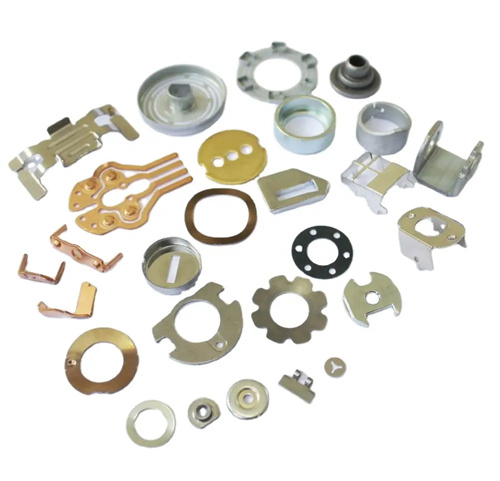Prevent scrap from bouncing back or blocking
Scrap bounce and material blockage are common problems in stamping production. They not only affect production efficiency but can also damage molds and equipment, and even cause safety accidents. Scrap bounce occurs when the waste generated by punching rebounds back into the mold working area due to elastic deformation or airflow after the blanking force disappears. Blockage occurs when waste accumulates in the discharge channel, preventing it from being discharged smoothly. Preventing scrap bounce and material blockage requires a systematic solution encompassing multiple aspects, including mold structural design, optimized discharge channels, and the configuration of auxiliary devices.

Die cutting edge design is fundamental to preventing scrap bounce. Proper cutting edge angles and clearances effectively control scrap separation. The punch cutting edge should be designed with a slight negative angle (-1° to -3°) or a rounded edge (R0.02-R0.05mm) to create a downward tilt during the punching process, reducing the possibility of rebound. The die cutting edge must be sharp to prevent excessive scrap deformation and rebound caused by edge wear. For materials thicker than 3mm, the die cutting edge can have a positive angle of 0.5°-1° to enhance scrap discharge guidance. The clearance between the punch and die must be uniform and meet design requirements. Excessive clearance can easily cause scrap bending and deformation, increasing the risk of rebound. Excessive clearance increases friction between the scrap and the cutting edge, potentially causing material jams. For example, when punching mild steel, a clearance of 8%-10% of the material thickness is recommended to ensure punching quality while minimizing scrap bounce.

Optimizing the design of the discharge channel is key to resolving the blockage problem. The channel’s size, shape, and slope must ensure smooth waste discharge. The discharge hole diameter for round waste should be 5-10mm larger than the waste diameter. For square or irregular-shaped waste, the hole’s outline dimensions should be increased accordingly to prevent the waste from becoming stuck in the channel. The discharge channel’s slope is generally no less than 30°. For more viscous materials (such as stainless steel), the slope should be increased to 45°-60° to utilize gravity to accelerate waste discharge. The channel’s inner wall should be polished smooth, with a surface roughness below Ra1.6μm, to reduce friction between the waste and the channel. For long, strip-shaped waste produced by continuous punching, guide plates or spiral grooves should be installed in the channel to guide the waste out in the desired direction and prevent entanglement and blockage.

The use of auxiliary devices can further enhance the effectiveness of preventing rebound and material jams. Common auxiliary devices include air blowing, suction, and scrap cutting devices. The air blowing device uses compressed air (0.3-0.5 MPa) to blow the scrap material toward the cutting edge at the moment of punching, pushing it toward the discharge channel to prevent rebound. The air jet should be aligned with the scrap separation point and maintained at a distance of 10-15 mm from the cutting edge. The suction device is suitable for small scrap (less than 5 mm in diameter). It uses negative pressure (-0.06 to -0.08 MPa) to draw the scrap into a collection bin, preventing it from rebounding or floating. The scrap cutting device is used to process long scrap. A rotating blade or shearing mechanism is installed in the discharge channel to cut the scrap into small segments of 300-500 mm, preventing long scrap from snagging and blocking the channel. The cutting action must be synchronized with the stamping cycle , ensuring that the scrap is cut every 3-5 punching strokes.

A properly configured waste collection and conveying system is the last line of defense against material blockage. The system must seamlessly connect with the mold discharge channel, avoiding steps or corners. The collection box inlet should be aligned with the discharge channel outlet, with a height difference of no more than 50mm. A buffer plate should be installed at the inlet to reduce the impact of falling waste. For large-scale production, automated conveying devices (such as screw conveyors and belt conveyors) are required to transport waste from the collection box to the waste bin. The conveying speed must match the waste generation rate to ensure that excessive waste does not accumulate in the collection box. The conveying device’s drive motor must have overload protection to automatically shut down in the event of a blockage to prevent equipment damage. For example, the waste conveying system of an automotive panel stamping line uses a chain conveyor with a width 200mm larger than the maximum waste size and an adjustable speed (0.5-1.5m/s), which can effectively handle the continuous discharge of large quantities of waste.

Routine maintenance and parameter adjustments are equally important to preventing scrap bounce and blockage, and a regular inspection system is necessary. Before each shift, clean the discharge channel to remove residual scrap and oil. Check cutting edge wear and promptly reground any edge radius greater than 0.1mm. Test the pressure of the air blowing and suction devices to ensure they meet design requirements. Closely monitor scrap discharge during production. If signs of bounce or blockage are observed, adjust the punching speed (high-speed punching is prone to bounce and can be appropriately reduced to below 300 strokes/min) or the clearance. For the initial production of new materials or parts, test punches are performed to verify the process. Based on the scrap material’s morphology, optimize the die structure and auxiliary device parameters, and create standardized process documentation to guide subsequent production. By combining these measures, the incidence of scrap bounce and blockage can be reduced by over 90%, ensuring continuous and stable stamping production.
